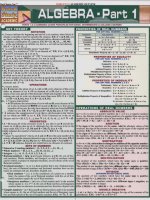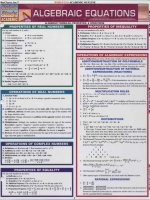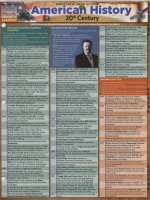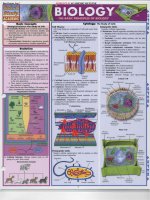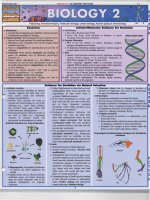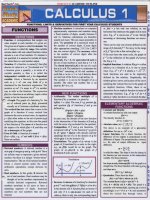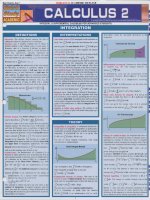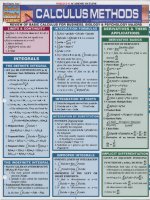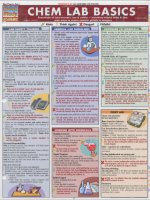Quick study academic pre calculus 600dpi
Bạn đang xem bản rút gọn của tài liệu. Xem và tải ngay bản đầy đủ của tài liệu tại đây (6.89 MB, 4 trang )
FUNCTIONS
A. A function is a rel ation in wh ich each el ement of the d oma in (x value
- in dependen t va ri a bl e) is pa ired w ith only one e leme nt of the ra nge
(y value d epe n de nt va riable).
B. A re lation can be tested to see if it is a funct ion by the vertical lin e test.
Draw a vertical line throug h a ny g raph, and if it hi t an x- value more than
on ce, it is not a functi on . (1-4)
b. b 2 4ac = 0, exactly one rea l r ot
c. b 2 - 4ac < 0, no real roots (two disti nct imaginary roots)
I) Example l:f(x) =x2_4x+ I use
f( x)=
[!]E8rnrn
FE
A function
Not a function
A function
A fu nction
C. Linear funct io ns ta ke the form: f(x) = mx+b, or y =
m x+b where m = the. lope, and b = the y-intercept.
Examp le: f(x ) = 4 x-l , the s lo pe i 4/1 (ri e ove r run), and
th e y-intercept is -I.
D. he dis tance between two points o n a lin can be found
j( X 2 -
u ing the distance form ul a, d =
XI ) 2 + ( Y2 - YI )2
X I)
•
Vd ).
(Y 2 +
2 '
F. The s tan dard form ofa linear functi o n is 0 =Ax + By +
C. The lope is m = -A/B, and the y-intercept is -C/B.
G. The zeros of a fun ct io n a re fo und by setting y to O. and
solvi ng for x.
I. E xam ple .1: f(x) = 4x-1 (5)
2. Exam p le 2: f(x) = 6, thi s func tio n has no zero, and is
a h ri z ntal lin e th rough +6 o n the y-axi . (6)
3, Exam ple 3: x = 4, th i i not a function, because the re
is a verti ca l line through +4 on the x-axi , g ivi ng a n
in fi n ite set of va lu es for y. (7)
X;~~5
ffi
the
discriminan t is > 0, the re are two rea l roots. (15)
2) Example 2: f(x) = 2x2 + 2x + I us ing b 2 - 4 ac =
-4, since the d isc rimin ant is < 0, there are two
imaginary root . (16)
3) Example 3: f(x) = x2 + 2x + I us ing b 2 - 4ac = 0,
· ..
. 0 th
'
I
17
ere IS one rea I' \. ( )
since t1le d ISCnl11l11ant IS =
. .
g(x)
J . RatIOnal fun ction s take the fo ri: f(x ) = b (x) .
I . The pare nt fu nction i f(x) = X ·
~2
x-
+ 3 (21)
E
3
E
/
x= 1.2765957
y=-2. 106855
Two real solutions
E
4
E
a . Find th e sum : (f + g)(x), x + 2 + ~
( x + 2 ) (x - 4) + x
X2 _ X _ 8
x
x- 4
= x - 4 ' and x f. 4.
b. Find the di fference: (f - g)(x), x + 2 - ~
(x + 2) (x - 4 ) - x x _ 3 x _ 8
x
x- 4
=
x_ 4
• an d x f. 4.
6. Example 2: Gi ven f(x) = x + 2, g(x) = x:. 4
a. Find the product: (fxg)(x), (x + 2)( x :. 4 ) =
x 2 + 2x
---x=-;t.
an d x f. 4.
b. Find the quot ient: (
X - 4)
Example 2: f(x) = 2xJ + x2 - 2x + 3, thi function has
one rea l zero at x = -1.17, and two non -rea l roots. (8)
(x+2) (.-x- =
t
)(X),
x;x+_2 4 =
x2 -2x - S
x
x~930B511
, andx f. O.
:. 4
+ 2.
2(
4)
x ( x - 4)
+2
Example: Gi en f(x)=x+2, g(x)=
Find IfogJ(x): f ( x :. 4
( _ x_ + 2 )
x - 4
+2
=
+ 2) =
x
+
5x - 16
, and x f. 4.
x- 4
M .lnve r se function s : If og l(x) = Igo fj( x)
- b ± jb 2 - 4ac
x=-1.010638
2a
can y=2.9737903
Example: Given f(x)=2x - 4, g(x) = · +4
'-2X+4)_- 2 (X-2+4) - 4 -_x,
Ifog l(x) -_f (
x-- 0265958
y~.OlO0806
A rationalfunction
with asymptotes
at the x & y axes.
F
O E
~,
be u ed to f ind the roots of a ll quadratic eq uations.
6 . The a lue under th sq uare root symbo l is ca ll ed the
d iscrim in an t. It te ll s u the type of roots o f a quadratic
equat ion .
( 2X
and IgO fj( x) =
di st inct rea l roots
1
-
4)
2
x=-.5053192
y=.47379034
Two imaginal)!
y=.00478157
L. c om P.osition of functions:lfog l(x) = f(g(x» E
8
!J
Example 3 : f( x) = x 2 + I. this fUllction has'two nonreal roots, (9)
x=. 10638298
l. Qua dra tic funct ions take the form : f(x) = ax 2 + bx + c. y=1.0113173
I. 111e graph ofa quadrati function i called a parabola. (10)
o E
2 . ome parabolas ar e qu adrat ic eq uation , but not t
q uadratic fu nctions. (II)
3. Quadrati c functions or equat ions can have one real
so luti on. two rea l solutions, or no real so luti on. (12-14)
4 . Th vertex of a parabo la i ca ll ed its critical p oi nt.
EE
ra
ra
x=1.3829787
y=-2.671371
Two real roots,
(.26,0) & (3.73,0)
5. Example I: Given f(x) = x + 2, g ( x) == x:. 4
Example l: f( x) = 2x4 + x 2 + X + 10, has a degree of
4, there are fo ur roots (so lutions) to th is po ly nomia l. 9
t lVO
y=-.0100807
One real solullOn
. (f)
EE
tE
a. b 2 - 4ac > 0,
x = -(-4)
f< - 4 2 _ 4)/2 = 3 .732, and
- f< - 4 - 4) /2 = .267. s ince
K. Oper ations of fu nctions:
I. Sum: (f + g)(x) = f(x) + g(x)
2. Diffe rence: (f - g)(x) = f(x) - g(x)
3. P rod uct: (f x g)(x) = f(x) x g(x)
f( x)
4. QuotIent: g (x) = g (x )' g( x) f. 0
No zeros
+ cx n-2 ••• + d x + e
I . When the hi g he t power o f the func ti on is a n odd
intege r, there is at least one real zero.
2 . When the h ighe t powe r is a n even integer, there may
be no real zeros .
3. Both type can have imag inary roots of the form a + bi.
x=-1.170213
4. T h hi ghest p wer of a po lyno mi a l w ith o ne vari able is
y=.0100806
ca ll ed it degr ee.
=
x = -(-4) +
6 . Exa mple 3: f(x) =
H. Polyno mial function s take the form : f(x) = ax n + bx n- I
). The quadratic equat ion f(x)
2a
2. Th e g raph of these functi ons cons ist of two pan s, one
in quadrant I, and one in quad rant 3.
3. The bran hes of rational functi on approac h line
call ed asy mptotes. (18)
x
x=-.9574468
4. Exa mple I: f(x) = x + 3 (19)
y=7.9737903
No real solutions
3
5. Exam ple 2: f(x) = x (20)
E. The mid-point of a line segment can be found us ing the
..
( X2 +
m id -po lllt for m ula,
2
-b ± /b 2 _ 4ac
+4
= x.
x=.02659573
y=-.0100806
The asymptotes
are the axes
y1=x~2x+1
One real rOO! (-.93,0)
N. Families of functions : Graphs of fu nction fami lies. Changes in va lues of
the parent affect the appearance of the paren t g raph. A par ent g ra p h is
the basic grap h in a fam ily. II the other fa mily m mbers move up, down,
left. right, o r turn based on changes in va lues .
I. Polynomia l fun ctions 1:
3. A bsolute value fu nctions:
a. f(x) = Ixl (38)
a. f(x) = x 2 (22)
b. f( x) = 2x2 (23)
b. f(x) = -I xl (39)
c. f(x) = .5x2 (24)
c. f{x) = 12xl (40)
_
2
d.( f(x) = 1.5xl (41)
d.f(x) - -x (25)
e .f(x) = Ix + 21 (42)
e . f(x) = x 2 + 2 (26)
f. rex) = Ix - 21 (43)
f f(x) = x 2 2 (27)
g . f(x) = Ixl + 2 (44)
g. r(x) = (x + 2)2 (28)
h. f(x) = Ixl- 2 (45)
h.r(x) = (x - 2)2 (29)
2. I>olynom ial function s 2:
a. f(x) = x3 (30)
b. f(x) = _x3 (31)
c. f{ x) = x3 + 2 (32)
d.f(x) = x3 - 2 (33)
e. f( x) = 2x3 (34)
f. f( x) = .5x3 (35)
g. f( x) = (x + 2)3 (36)
h.f(x) = (x - 2)3 (37)
A. Rectangula r coordinates arc o f the form (x,y), and arc pl otted on the
Cartes ian coord in ate syste m.
B. Poin ts are p lotted w ith two va lues, one the absci sa and the other th
ordinate.
C. T he absc issa i the x-va lue, call ed the domain. and th e ord inate is the
E
S f]
y- va lue, called the range.
/P
D. Many di ffe rent shape and func tion can be drawn on the
Ca rt e ian system.
E. Here is a g ive n ang le, orig inating fr
the
III
-axi
and
rotating counter-clockwise. Th is ang le is re prese nted by a
P(4.6)
li ne segment ori ginati ng at t.he o ri gin, and extend in g to a
given poin t (P). (46)
R Pola r coo rdinates are o f the fo rm P( r, 9), where r
E
7 B
,p
= the
I
(.
radiu , the di stance from the o ri g in (0,0) to I) (a g iven
po int), and El = the magnitude o f an ang le.
I. If r is pos iti ve,
e is
P(H,O)
the meas ure o f any a ng le in
sta nd ard pos ition th at has segm ent 0 ,1' a its te rmina l
s ide.
2. If r is negative, El is the measu re of any ang le that has
ray o ppos ite segmen t O, P as its ter mina l side.
th
(47&48)
22
EEJ
P(-r,9)
G. Graphing w ith polar coordi nates :
I. Exa mp le I: 1'(4, 120 d egr ees) (49)
2. E xa mp le 2: P ( 4. ~ ) (50)
H. O ne angle graphed w ith polar coordinates can
I'
presen t
seve ra l angle .
I. If Pis a po int w ith polar coo rdinate (r, 9), then l' can
also be g raphed by t he po lar coordi nates (-r,
ffi
P(4, 120)
e + ( 2x + 1)1t) or
(r, e + 2x1t), where x i any in teger.
2. E xa mlJle: S how fo ur differ nt pa ir ofp la r coo rd inate th at ca n be re prese nte d b the po int 1'(3, 60
r
a n
.
I.
degrees).
3. (-r,
e + (2 x + 1)1 80 d egrees) ~ (- (3), 60 + (1)180)
(- (3), 60 - (1)1 80),
4. (r,
= 1'(-3, 240) or 1'(-3,120)
P(4'3)
e + 360x) ~ P(3, 60 + (1)360) or 1'(3, 60 + (2(360)
= P(3, 780)
hanging from rectangula r to pola r coordina tes : The fo ll owing
fo rmulas are used to make thi s change:
j( x
f,
+ y2) , e = A rctan x > O.
2. 9 = A rc ta n
+ 11:, X < 0, a nd fj = r adian s.
3. E xample I: Find the polar coordinates f, r 1'(-2,4). r =
I. r =
=
2
f
j20 = 4.47. e = Arcta n
j
_ 2)2 + ( 4 )2
_42 + 1t = 2.03, P(4.47, 2.03).
4 . Exam ple 2: Find the po lar co rd inates for P(3 ,5). r =
5
34 = 5.83, El = A rcta n "3
= 1.03. P(5.83, 1.03).
~_~
j()2+ 5 2) =
hanging fro m polar to r ecta ng ular coordinates: The formulas used to
make thi s change are :
I. x = r cos El
e
3. ~~a~Ple 1:
2. v
=r
sin
P ( 4.
~),
x = 4 cos
( ~)
= 2,
an d 4 s in
(~)
=
3.46 - P( 2, 3.4(h.
4. Exa mple 2: P(5, 60°), x = 5 cos (60)
= -4.76. Y = 5 si n (60°) =
-1.52 =
P( -4. 76, -1.52).
K. Grapbing imaginary numbers with po lar coord inate: The polar
form of a complex number i x + yi = r(cos El + i s in e).
Example: Graph the complex number -4, + 2i, and change to polar form.
r =
;;r+yL =
j(_ 4
2
+ 2i 2)
= /16
+4
=
,fiO = 4.47, El =
rctan
( _24 ) + IT = 2.68,1)0Ia r fo rm = 1'( -4, 2 i) = 4.47(cos 2.68 + i sin 2.68)
2
A. The notation P( n,n) = the num ber o f permutations of n objects taken all
at one time.
B. The notat ion P(n,r) represents the number of perm utation of n obj cts
A. Exponential properties:
I. Multiplication: x· xh = x. + b
E xample: x 2x 4 = x6
take n r at a time P (n,r)
2. Division : (;: ) = x·- b
Example:
4. Distribu tion with d ivisio n: (
r
y
y/ = ( ;: )
= x:
18·17·16·15·14·13·12·11·10·9·8·7·6·5· 4 ·3·2·1
.
h
6.5.4.3.2.1
, not!cetatyou
y
can ca ncel 6!, leaving 18 ~ 7 = 8.89 X 10 12 choices.
Example 3: A combination lock has four tumbl ers, and i num bered I
5. Power of a power: (X") b = x· b
Exam ple: (x 2)3 = x6
6. Inverse power: x-I = {
x"" = ~
x
7. Root power: xI I. =
Example : XII2
20 on the dial. How many combinations are possible . P(20,4)
.j;
= j;
R
bR
B. Logarithmic Properties and Logarithmic Fo rm:
EE
FE
EB
EfJ
t§
1. Logarithmic Form: log.x = y, thi s is read a "the
exponent of a to ge t the result x is y."
1
Exa mple: log, 100 = 10, the exponent of x to get the
res ult .100 = 10 or x lO = 100.
2. Loga rithmic I)roperties :
a. M ultiplication: log.xy = log.x + log.y
b. Division: log.
y= logax - log.y
* log.x
= logaY' then
c. Power p rope rty: log.x b = b
d. rden tity property : If log.x
x= y
3. Change of Base p rope rty: I Lx, y and z are + nu mbers.
log ) z
and x and }' are n t = I , then, log, z = -I - - .
og)x
C. Solving logarithmic equations:
Exa mple I: Write log 1000 = 3 in exponential form:
10" = 1000
Example 2:
olve, log,
Ii
=
i~
x l/4
=Ii
24 - 3x. x = 6.
Example 4: log (2x + 8) - log (x + 2) = I
+8
~
~
8x = -12
(2x + 8)
10 1 = (x + 2)
~
Exam ple 5: log, 5 =
-*
~
log
IOx +20= 2x E
6 EJ
x = - L5.
~ x- 1/3 = 5 ~ x = - 1~5.
Exa mple 3: y = 2 2. - 1 - I (53)
Exam ple 4: y =
+ I (54)
Example 5: y = logz
E xample 6 : y = log2(x - 2) (56)
E xample 7: y = log2(x - 2) + 2 (57)
Example 2: How many word pattern can be form ed from Mi issippi ?
ll!
2!2!2!4! = 207,900.
Example 3: There are 24 ch ild ren who are going to play dodge ball. 10
of the m w ill start out in the circle. Ilow many ways cou ld the
remai ning children fo rm ci rcular combinations? (n-I)! = 13! =
6,227,020,800.
E. Combinations: Di ffer from permutations in that order i not a cons ider
II! )
.
r !r!
Example 1: A book c lu b ha selected e ight books to read, how many four
ation. The number of n objects taken r at a time is C(n,r) = (
11-
group com binations are pos ible?
~
qn,r) = (
8! )
= 70
8 - 4 !4!
Exa mp le 2: How many five card hands an be dea lt from a regu lar deck
52'
o f card s? qn,r) ~ = (52 _
!5! = 2598960
5)
A. Synthetic division is a method used to make long d ivision of p Iynomial
les cumbersome .
I. It is ma inly used when you have a very long numeral r.
2. It ca n only be lIsed wi th a di i or in the form (x - n).
3. You can convert the form (3 x + n) to (x + 1/3n) and then use sy nthetic
divis ion.
B. Synthetic Division of the fo rm x2 - 3x - 54.;- x - 9.
I. Example I: T he standard way of d iv iding polynomials
3x - 54
x + 6
Btl
ttJ
Exam ple I: y = 3 ', and (1/3)' on the same grap h. (51)
Example 2: y = 92 +1 (52)
Repetitions: The number of n objects of which x & yare alike = ~.
.y.
C ircular Pattern s = (n-I)!
Example 1: How many word arrangemen ts can be made from the word
5!
radar? n = 5, x&y = a&r = 2. 2!2! = 30.
x - 9 )X 2 -
D. Graphi ng Exponent ial and Loga rithmic Equa tions:
22>-1
;gi
~
(xI /4)4 = (1i)4 ~ x = 4.
5
Example 3: logi2x - 6) = log4(24 - 3x). 2x - 6 =
2 + 8)
(x +2 ) = I
~
_ 20·19·18·17·1 6 ·15·1 4 ·13·12·11·10· 9 · 8 · 7 · 6·5 · 4 ·3· 2 ·1 _
16·15· 14 · 13 ·1 2 ·11·1O·9· 8 ·7·6·5·4 .J.2 ·1
116,280.
Example 4: If26 people enter a 16-mile race and all of them finish, h w many
possi ble orders of fin ishing are there? P(26,26) = 26! 26! = 4.032 x 1026
D. Permutations th at contain repetitions or are placed in a Circular Pa ttern
8. Rational power: x· /b =
Exa m ple: x312 =
I
11.) I'
Il - r .
Exa mple I: How many ways can fi ve cartons of cereal be arranged?
P(5,5) ~ 5! = 5432 I = 120
Exa mple 2: If 18 people show up to serve on ajury, hO\ many 12 person
18!
P (1 8, 12)
juries
ca n
chose n?
be
( 18 -12 ) !
3. Distribution with multiplication : (xy)· = x·y·
Exam ple: (xy )s = x Sy 5
Exa m ple:
(
C. The notation n ! is read as n - factorial.
(::..64) = x lO
Exam ple: (
= !, P(n,r) =
x - 9 ) X 2 - 3x - 54
_(x 2 - 9x)
6x - 54
-(6x - 54)
o
Answer = x + 6 r. 0
2. Using synthetic division, we use the econd part of the divi or, but change
the sign (+9, trom the above example). We then Ii I the coefficients of the
div idend. From th e example above, th y \\ould be I, -3, -54.
Then bring down the coefficients one at a time, mUltiply them b} the
divisor (+9), and add them to the next coefficient. T his gives the same
result. From the example on pg. 3:
1-8
3
31
6. The product of a scalar (x), (a va lue with magn it ude, but no d irection),
and a matrix (.I) is d, with eac h e le ment f ..1 mu ltip lied time the
2..1 1 -3
-54
9 54
1 6 0 An wer = x + 6 r. 0
Note: The power of x a lways begins one lower in the answe r.
Exam ple 2: 3x3 + x 2 + 5x - 2 -;.- x + 1 -?
··
.
I 12 24 - 36 1
.
va I
ue x. S IX tIm es the matrI X .I =
1-1 8 0 12 1
7. The product of 2 - two by t\\'o matrices i a two b two matrix. The
::.113 1 5 -2
-3 2 -7
3 -2 7 -9
nswe r = 3x 2 - 2x + 7 r. -9
Examp le 3: In the follow ing example, noti ce that there mu t be a
place-ho lde r fo r missing powers of the variable. Z4 + Oz3 + Oz2 +
Oz + 16 -;.- z + 2
procedure isa fo llow: .J = 12
16
JxK='2 ( 6 ) + 4( 3 )
-21
0 0 0 16
-2 4 -8 16
I -2 4 -8 32 Answer = z3 _2z2 + 4z -8 r.32
C. S nthetic di vi ion of the form 3x2 + lOx - 9 + 3x~2. In thi example, all
nu mber are first divided by 3, then at the end of the process a ll fractions
are changed by mul tiplication.
Exam pie 1: 3x - 2 ) ( 3x 2 + lOx - 9) become x -
tl
t )(
X2
+
lj) x -
t
- 9
10
"3 3
8
2
3
3
4
t'
now mult ipl y a ll fract ions by 3.
Exam ple 2: 2x - I )( 6x 4 - x 3 - Ilx 2 + 9 x - 2), now div ide all parts
by 2, and use s nthetic divis ion .
3
1
II
9
2 -I
I
5
-5
2
-2-2
3
2 - 2
2
3
Add row 3 to
Aga in, when standard long di vision is perfor m d, the same answer is
atta ined . Note: II' there w re any frac ti ons in a ny part of the an wer,
they wou ld be removed by mul tip lication.
I I -2
I' W
I 1 -2 I : 7 I
107 0 :-7 1
10 0 ~ : 12 1
2
-2 1 I: 7 I
01 0: - I I
004 : 12 1
I -2 I : 7 1
o I 0: -I I
o 0 I: 3 1
Mu lt iply row 2 by 117
Multiply row .... by 1/4
MATRICES
A. Matrix:
rectangu lar array of elements in columns and rows. Rows are
named before columns, therefore a 2x4matri x has two rows and four colwnn .
Mu ltiply row 2 by 2 and add to row I
B. Prope r ties of Ma trices:
I. A ma trix with on l one row is called a row ma tri x.
2. matri th at ha onl. one o lum ll i ca lled a col um n mat rix .
3. Two matri ces are equal if and only if they have the same dimensions
and co ntai n the same identical e lements.
4. The sum o r a 2x3 and a 2x3 matrix is a 2x3 matrix in which the
e lements are added to the cor respond ing e leme nts.
Exam ple: Find.1 + K ifJ
= 1 2 4 -6 1and K =
1-3 0
f3
9
15
-3
21
Multiply row
1
2 4 -61
21
J
and K =
1-
-9
21
I
3
II
1 00 : 2 1
00 1 : 3 1
The solution set = 2, -I, 3.
21
IS BN- 1 3 : 97 8 - 14 2320248- 6
IS BN- 10 : 142320 2 48 -1
-'i'
J~111 1
IlI1lllllllil1llillllil
U.S. 54.95 CAN . $7.50
Author: S. Orcutt
"" rlpU, re)oo:n~J Nil ran Q(lh, pul.h,,;lil, .. I1'\1\ lit ICprod U' d ... IBII mil .. Ift.-\
r"nn vr b, an) mean~, 1:1«1100'''' Of rIW\n.n, •• Indu"h" pNII.,.;;"" rc..:.'I"d, .... "'
,"11,, 11\4111<.) " >I""I~ and rttrloal ,,>W'tn .. uhuIK llIt,lIm P"TlfilU,,1fI r">fI the ~h Iwr
20111 l(IIJb K.r< harb. l .f. 1t,,87
5. The ditference of two matrices.J - K is equa l t add ing J to th e add itive
1- 3 0
by -I and add to r w I
I0 I: 5I
010: -I i
00 1 : 3 1
o I 0 : -I I
.J +KJ5 13 - 4 1.
12 - 3
II
inverse of K. .I =
26 1
6 ( 9 ) + l( 2 ) 1 139 56 1
[6 ( 6 ) + t( 3 )
C. sing matn ce to solve sys tems of eq uat ions: If you have thr e systems
of eq uation yo u can use an augmented matrix to find the solu tion et of
the va ria ble. You mu t fo llow the e guide li nes:
I. Any two rows Illa be interc hanged.
2. ny row may be repl aced by a non-zero multiple of that row.
3. Any row may be replaced by the um of that row and the multiple of
another. The goa l is to achieve an augmen ted matrix of the form;
110 0 : x,1
10 I 0 : y I
100 I : z I, where x, y, z = the olution el.
Example : Solve x - 2y + Z = 7
3x + Y - z = 2
2x + 3y + 2z = 7. u ing an augmented matrix.
Answer = 3x3 + x2 -5x + 2 r. 0
0
9 1.
21
2 (9) + 4( 2 )IJ 24
The aug mented matri i
Answer = x + 4 r. -1. When th i sa me problem is performed with trad i
ti onal divi sion, the an wer i the same.
tl
41 ,1 6
I I 13
I: 7 I
13 I -I : 21
12 3 2: 71
Multiply row I by -3 and add 10 rO\ 2 I I -2 I: 7 I
107-4:-1 9 1
12 3 2: 7 1
MUltiply row I by -2 and add to I' w 3 I I -2 I: 7 I
10 7 -4 :-19 1
10 7 0: -7 1
Mu ltiply row 2 by - I and add trow 3 II -2 I: 7 1
I 0 7 -4 : -1 9 I
100 4 : 12 1
1
-3
Answer = x + 4 r. -
-5 - 81
J-K J -I
.1\
free di wllloadS &
h n red~ of t Itles . t
qUlc sluaY.COm
4
6111Ill~~ll~II~~ijI11111118
